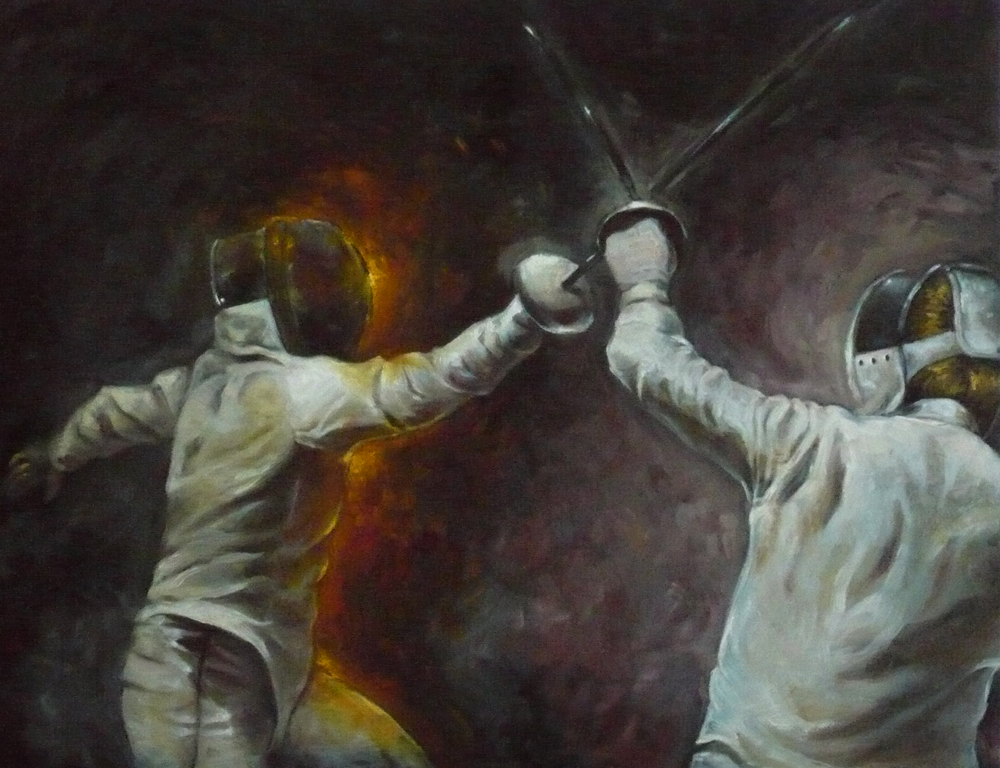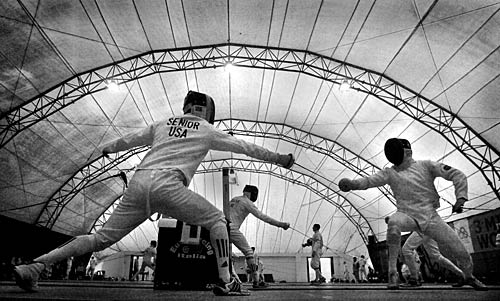Pada zaman penjajahan Belanda di Indonesia, para tentara Kerajaan
Belanda membawa serta olahraga anggar masuk ke Indonesia. Pada saat itu
terdapat dua macam tujuan permainan anggar, yaitu untuk berkelahi dan
olahraga.
Kemampuan bermain anggar untuk berkelahi diwajibkan bagi setiap
tentara Hindia Belanda (KNIL) dengan menggunakan kelewang (pedang) atau
sangkur. Sedangkan, permainan anggar untuk olahraga dipersilakan bagi
para bintara, perwira, serta mahasiswa.
Tokoh-tokoh militer bangsa Indonesia yang mempunya keahlian bermain
anggar pada waktu itu antara lain adalah Drh.Singgih, Soeparman,
Maryono, Setu, Warsimin, Paimin Salekan, Atmo Soewirjo, J. Sengkey,
Suratman, Mantiri, C.H. Kuron, Mangangantung, dan Soekarno.
Untuk dapat meningkatkan kemampuan bermain anggar maupun olahraga
lainnya, KNIL mendirikan sekolah olahraga militer. Sekolah olahraga
militer tersebut didirikan guna untuk mendidik para guru anggar, guru
renang, dan guru olahraga lainnya. Lembaga pendidikan militer tersebut
didirikan di Bandung dan Magelang.
Pada masa penjajahan Jepang, tidak ada informasi yang masuk tentang
perkembangan olahraga anggar di Indonesia. Dalam masa perang
kemerdekaan, banyak guru anggar yang berasal dari mantan instruktur
militer Belanda yang menjadi instruktur di Akademi Militer Yogyakarta.
Mereka mengajarkan cara bermain anggar, baik untuk olahraga maupun
berkelahi dengan menggunakan sangkur.
Dalam Pekan Olahraga Nasional pertama yang diselenggarakan pada tahun
1948 di Solo, olahraga anggar mulai diperkenalkan serta dieksibisikan
oleh para guru anggar mantan instruktur militer Belanda tersebut.
Setelah penyerahan kedaulatan Negara Republik Indonesia, para guru
anggar yang tersebar di tanah air mulai mengembangkan olahraga anggar
dengan cara mendirikan perkumpulan-perkumpulan anggar di beberapa
daerah. Seperti di Sumatera Utara, Jakarta, Bandung, Jawa Tengah, Jawa
Timur, Sulawesi Utara, dan di Sulawesi Selatan.
Perkumpulan anggar di ibukota kita, Jakarta, didirikan oleh Kasimin
Atmosoewirjo, Soekarno, dan Drh. Singgih. Di awal tahun 1950, Kasimin
Atmosoewirjo mulai mengembangkan olahraga anggar di Jakarta bersama
dengan puteranya yang bernama Suratmin.
Perjuangan para guru anggar yang telah merintis olahraga anggar di
tanah air selanjutnya dikembangkan oleh para penerus. Baik oleh murid,
anak, maupun cucu, sehingga pada saat ini olahraga anggar dapat terus
berkembang di berbagai provinsi di Indonesia.
Setelah penyerahan kedaulatan Indonesia oleh pihak Belanda, permainan
anggar mulai diajarkan di sekolah olahraga maupun perguruan tinggi
olahraga. Di lingkungan akademi militer dan polisi juga sempat diajarkan
cara bermain anggar, namun pada akhirnya kurang berkembang.
Dalam perkembangan selanjutnya, olahraga anggar mulai dipertandingkan
dalam Pekan Olahraga Nasional kedua yang diselenggarakan pada tahun
1951 di Jakarta. Setelah itu olahraga anggar selalu dipertandingkan
dalam setiap Pekan Olahraga Nasional hingga sekarang.
PERKEMBANGAN DI INDONESIA
- Cabang anggar Indonesia, di SEA Games 2007 Thailand hanya kebagian
satu medali perunggu untuk nomor tim floret putri setelah dalam
semifinal kalah tipis dari Filipina 43-44 di Suranaree University of
Technology Nakhon Ratchasima.Sementara itu medali emas direbut tim
Singapura yang mengalahkan tim Filipina dengan 37-25 yang berhak atas
medali perak.Hingga berakhirnya pertandingan cabang anggar, Selasa
(11/12), Indonesia tidak mampu meraih medali emas, dan hanya mengoleksi
dua medali perak dari nomor floret perorangan putri atas nama Fabiola
Tirza Paulany Ratu dan tim degen putri.Selebihnya empat medali perunggu
dihasilkan dari degen perorangan putra atas nama Agustinus Pieter
Manuhutu, degen perorangan putri Isnawaty Sir Idar, dan dua dari tim
floret putra dan putri.
- Pengurus Besar Ikatan Anggar Seluruh Indonesia (PB IKASI) memanggil
dua atlet nasional untuk mengikuti Kejuraan Dunia Anggar Kadet dan
Junior 2010 di Baku, Rusia, pada 1-14 April. Ia mengatakan atlet Kaltim
yang dipanggil ialah Ima Safitri, sedangkan dari DKI Jakarta ada Aditya
Baskara. Aditya Baskara yang akan bermain di senjata floret putra kadet,
sedangkan Ima Safi tri akan bermain di nomor senjata sabel kadet.












